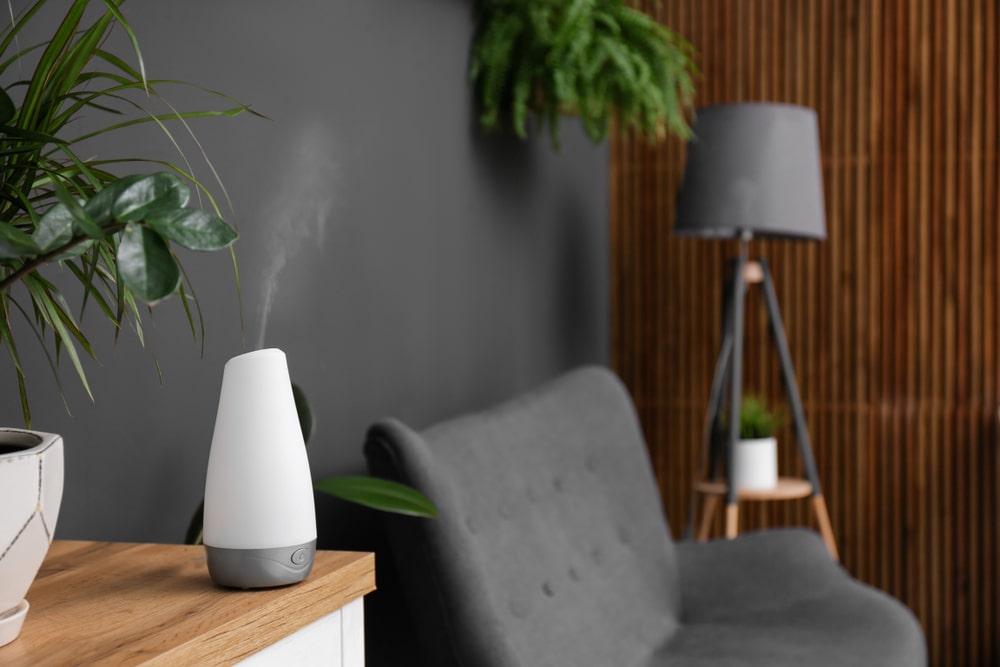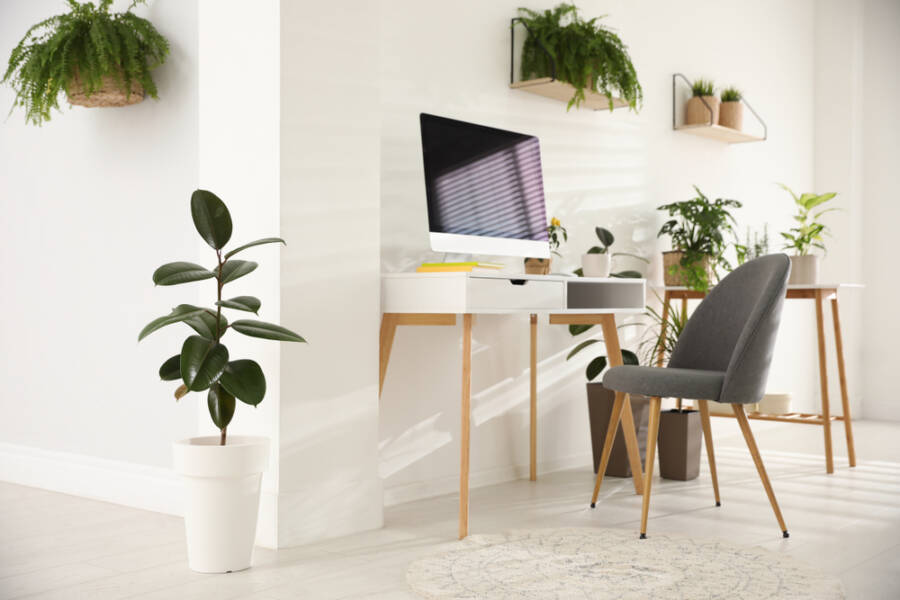The Baltic Blue pothos is an easy to care for plant that does well in a variety of conditions. They are tolerant of low light and can even thrive in artificial light, making them a great option for office spaces or rooms with limited natural light.
Are you looking for care instructions for your Baltic Blue pothos? If so, look no further! Here is a complete guide on how to take care of this houseplant.

What Is Baltic Blue Pothos?
Baltic Blue pothos is a type of epiphyte that grows on trees. It has long, thin roots that grow deep into the soil and help it to access water and nutrients. It has small, dark flowers that are pollinated by bats. It can grow up to 6 feet tall.
This plant can be found in Northern Australia all the way down to Malaysia, as well as throughout Indochina and in southern Japan, China, and Taiwan.
The Baltic Blue pothos is a common houseplant that is typically grown indoors in the United States. This plant makes an excellent addition to any home, and can be used as an accent or focal point for your living space.
What is the Baltic Blue pothos Scientific Name?
The Baltic Blue pothos is a plant that belongs to the family Araceae. The scientific name for the Baltic Blue pothos is Epipremnum pinnatum. The plant is native to Southeast Asia but has become naturalized in many parts of the world.
The leaves of the Baltic Blue pothos are bright blue, making it a beautiful tabletop plant.
The Baltic Blue pothos grows best in hardiness zones 9 to 11. The plant is often mistaken for the Monstera genus.
How Is Baltic Blue pothos Size?
The average size of a Baltic Blue pothos plant is 6 feet long; so don’t be surprised if yours grows up to that size too! To grow a big, healthy plant, provide the right growing conditions. While it’s not always necessary, adding some humidity will also be beneficial.
Some general tips to get a good size for Baltic Blue pothos that may help include watering the plant regularly and keeping it in a well-lit area.
What Color Is Baltic Blue pothos?
The Baltic Blue pothos has dark green leaves that turn blue after being exposed to sunlight. The name of the plant comes from the fact that the foliage of the Baltic Blue pothos is strikingly different from other Epipremnum pinnatum plants and is hence the source of its name.
The Baltic Blue pothos is a new cultivar that was discovered in 2022.
Is Baltic Blue pothos variegated?
The Baltic Blue pothos is a non-variegated plant. The Albo Variegata cultivar, however, is variegated. If your pothos starts developing yellow streaks that resemble variegation, it may be experiencing a deficiency or a fungal issue. Be sure to fertilize the pothos during its active growth season.
Overwatering can often lead to fungal problems, including variegation.

What is the Baltic Blue pothos’ origin?
The Baltic Blue pothos is a new variety of pothos that originated from a mutation of the Epipremnum pinnatum. In 2022, this plant was discovered in a nursery in Southeast Asia by Costa Farms. The name Baltic Blue pothos is not related to the Baltic Sea region.
Costa Farms released the Baltic Blue pothos as part of their Trending Tropicals collection later.
What Are the Best Ways to Care for Baltic Blue Pothos?
Baltic Blue pothos are easy to care for, but there are a few things you should keep in mind. This plant thrives in bright indirect sunlight, consistently warm temperatures, and higher humidity levels. You’ll need to provide it with bright, indirect light and keep its soil moist but not soggy
1. Place your Baltic Blue pothos in a location with bright, indirect light
Place your Baltic Blue pothos in a location with bright, indirect light. The best way to do this is to place it near an east- or west-facing window. You can also grow the pothos in a medium-light setting, but it won’t have as much of a blue hue to its leaves.
Keep the plant in a shaded area or only get early morning sun. Do not let the plant sit in direct sunlight.
2. Keep your Baltic Blue pothos in consistently warm temperatures
The Baltic Blue pothos needs warm temperatures to grow and thrive. You can grow the plant outside if you live in a USDA Plant Hardiness Zone 10 or higher. Moving the potted pothos outside on warm summer days will help keep it warm and healthy.
You should also keep your Baltic Blue pothos away from areas that experience extreme fluctuations in temperature, such as near draft windows and doors. This plant is not cold-tolerant and will not survive a frost.

3. Water your Baltic Blue pothos regularly
According to the research, you should water your Baltic Blue pothos every two to three days. You should wait until the top 2 inches of soil feels dry before watering.
When watering, make sure to water the entire potting mix until it is moistened. It is best to use the soak and drain method when watering a pothos plant.
Choose a porous pot for your pothos so that it can be watered more frequently if needed. Use less water in plastic pots than in teracotta or clay pots.
Checking the soil for dryness every few days will help you determine how often to water your plant.
Water your Baltic Blue pothos more often during the growing season, and reduce watering during winter months.
Also, keep in mind that you may need to water more often during hot summer months or if your plant is living in a warm space indoors.
4. Use well-draining soil for your Baltic Blue pothos
The Baltic Blue pothos needs a well-draining soil. A good soil mixture for the pothos includes equal parts potting soil, pumice or perlite, and orchid bark. The ideal soil will allow water to drain quickly and retain moisture. You can make your own well-draining soil for your Baltic Blue pothos by adding three ingredients listed above. Adding organic compost will improve the soils nutrient content.
Properly draining soil is essential for the health of your Baltic Blue pothos.
5. Mid to high humidity levels
To maintain a high humidity level for your pothos, use a drip tray. This will help keep the moisture level at 50-60%, which is ideal for pothos. You can also use a water dropper or humidifier to increase the humidity in their environment.
When it comes to increasing the humidity levels around your pothos, most people turn to drip trays. These shallow containers are filled with pebbles and placed on top of the potting plant. When you water the plant, excess water drains into the tray and raises the humidity level around your plants.
Alternatively, some people choose to use a humidifier in order to increase their plants’ natural moisture levels. Either way is an effective way of ensuring high-humidity conditions for your pothos.

6. Fertilize your Baltic Blue pothos occasionally
To fertilizer your Baltic Blue pothos, use an all-purpose liquid fertilizer diluted to half its strength and apply it once a month during the active growing season.
Do not fertilize your pothos during the winter. Follow the application directions and warnings on the fertilizer bottle.
7. Prune your Baltic Blue pothos from time to time
You should prune your Baltic Blue pothos from time to time to help control its size and shape. Pruning will also keep the plant healthy by removing any dead or diseased leaves.
Always use clean and sharp pruning shears when trimming your pothos, and be sure to sanitize the blades after each use.
By following these simple tips, you’ll be able to enjoy a beautiful and well-manicured pothos without having to worry about it growing too large or becoming leggy.
8. Repot your Baltic Blue pothos when needed
pothos need to be repotted every 2-3 years. You will know it is time to repot your Baltic Blue pothos when you see roots growing out of the bottom of the pot. At this point, you will want to remove the plant from its current pot and inspect the roots for damage or disease. Once you have removed any damaged or diseased roots, you can then repot your plant in a new pot with fresh soil. It is important to give your plant plenty of sunlight and water after repotting.
Repotting shouldn’t be done randomly; you should wait until the plant is actively growing before doing so in order to increase the chance of a quick and successful transplant.

9. Keep an eye on your Baltic Blue pothos for maintenance.
To keep an eye on your Baltic Blue pothos for maintenance, give it a monthly and a half shower, and knock off spider mites and other sap-sucking insects.
Let the water drain out of the pot before you take it under the shower.
How Much Light Does a Baltic Blue Pothos Need?
The best light for a Baltic Blue pothos is morning light. You can place a Baltic Blue pothos near a sunny window. It will also do well in a north-facing window. pothos needs a lot of light, but should have some shading during the summer months.
The Baltic Blue pothos does best in medium to high light, and should be close to an east- or west-facing window but no more than four feet away. The leaves may turn green when exposed to too much light.
What Is the Best Soil for a Baltic Blue?
The best soil for pothos is rich in nutrients and drains quickly. You can make your own soil mixture, or use commercially available soils that are rich in nutrients. Add organic compost to improve the soils nutrient content.
Epipremnum pinnatum needs a well-draining potting mix with good nutrient distribution. A mix of equal parts universal potting soil, orchid bark, and perlite or pumice is ideal for all types of pothos plants. Add a handful of horticultural charcoal to your homemade potting mix to help the plant absorb nutrients.
How Often Should You Prune Baltic Blue Pothos?
Pruning your Baltic Blue pothos is an important part of keeping it healthy and looking its best. The frequency with which you prune will depend on how quickly it grows and the overall size and shape you want to maintain.
Generally, it is a good idea to prune your Baltic Blue pothos every few months to remove any dead or dying leaves and to encourage new growth.
What Temp Can Pothos Tolerate?
pothos can tolerate a temperature range of 60-85 degrees Fahrenheit. However, they will not do well if the temperature drops below 55 degrees Fahrenheit. If the pothos is kept in a pot, it is important to keep it away from drafts and sudden temperature changes to avoid shocking the plant.
Baltic Blue Vs. Cebu Blue: Is Baltic Blue Pothos the Same as Cebu Blue?
Baltic Blue pothos and Cebu Blue are both types of philodendron, however they have different characteristics that set them apart. Baltic Blue pothos is more upright and has a more bluish hue, while Cebu Blue is a softer color and tends to be more horizontal.
- Baltic Blue and Cebu Blue pothos are different plants, with different leaf colors, growth patterns, and fenestration production.
- Baltic Blue pothos has darker and earlier-fenestrating leaves that make it closer to Cebu Blue pothos (Epipremnum pinnatum ‘Cebu Blue’).
- Cebu Blue is significantly more pronounced in its silvery blue hue than Baltic Blue pothos.
- The leaves of a cebu blue pothos will not fenestrate, while those of a Baltic Blue pothos will.
- The leaves of a cebu blue pothos will grow smaller than those of a Baltic Blue pothos, and they will also begin to grow earlier.
- You can display a cebu blue pothos in many ways, but the way in which a Baltic Blue pothos grows means that it can be displayed in any way that you like.

Is Baltic Blue Pothos rare?
The Baltic Blue is a type of pothos which can be found online and at local nurseries. It is not considered rare, and is relatively new, having quickly become available in many different stores. The variety was developed by the company which created it, as well as others who have propagated it via the cutting method.
If you’re looking for a new plant to add to your home, you’ll want to check out the Baltic Blue pothos. This variety of plant is quickly becoming popular in stores and online, as it offers many benefits. Not only can you purchase it from local retailers, but also from the company that developed this variety of plant.
So whether you’re looking for an unusual addition to your garden or something special for decoration, the Baltic Blue pothos is a great option.
Where to find a Baltic Blue pothos for sale?
If you’re looking to purchase a Baltic Blue pothos, the best place to start is by looking in your local garden center or nursery. Several big box stores – such as Walmart and Target. You can also order one online from Etsy, Amzon or Costa Farms website.
The average price for this plant is around $30, but it may vary depending on the size and condition of the plant.
Keep in mind that if you order the plant online, shipping may be expensive. If your local store doesn’t have the plant in stock, you can always ask them to order it for you.

What Are the Benefits of Baltic Blue Pothos?
Baltic Blue pothos is an easy-to-grow plant that thrives indoors or outdoors in most climates. The leaves are large and glossy, making the plant a popular choice for adding a splash of color to any room. The flowers are small but brightly colored, and the plant has long bloom periods.
1. Vibrant color
Adding a Baltic Blue pothos to your home decor can really add some vibrancy to any space. The plant’s color is a rich, deep green that starts to have a bluish tint as the plant matures. Its foliage will develop fenestration – which means it leaves splits and has holes.This stunning foliage with a blue hue is definitely eye-catching and will add some pizzazz to any room!
2. Easy to care for
The Baltic Blue pothos is an easy plant to care for. It can tolerate low light and average home temperatures and humidity. The plant can be left trailing or encouraged to climb.
3. Perfect for indoor or outdoor spaces
pothos can be used indoors or outdoors and prefer medium to bright indirect sunlight. However, if your space is light-challenged, try using LED lights as a supplement light source. It’s important to keep pothos away from direct sunlight to avoid burning their leaves. If the temperature drops below 50 degrees, it’s best to bring pothos indoors.
4. Can tolerate low light conditions
The Baltic Blue pothos can tolerate low light conditions and does best in bright, indirect light. The best location for the plant is 3–4 feet away from an unobstructed window in an east or west-facing room. Diffuse, direct light coming in from a window with sheer curtains or blinds is fine, as long as artificial lights are also indirect.
5. Drought tolerant
Baltic Blue pothos is drought tolerant and does not need to be watered as often as other varieties of pothos. It prefers a well drained soil and tolerates a slightly acidic soil. Baltic Blue pothos should be fertilized with a balanced fertilizer every now and then to keep the plant healthy and lush.
6. Heat tolerant
Baltic Blue pothos is heat tolerant and can tolerate a temperature range of 65°F to 85°F (18°C to 29°C). The plant will thrive in the average home temperature but will struggle to grow in temperatures below 55°F (13°C).
When growing this plant, it is important to take precautions in order to avoid exposing them to sudden hot and cold drafts. Make sure the plant doesn’t stay close to an air conditioning unit or a heating vent, as this can lead to damage.
7. Easy to propagate
It is easy to propagate Baltic Blue pothos, just like all the other pothos. propagating Baltic Blue pothos in Sphagnum moss or water is a simple and enjoyable process. It is easy to propagate a pothos by clipping and planting roots from cuttings.
See “How to Propagate a pothos in Water” for more information.
8. Rarely needs repotting
Baltic Blue pothos rarely needs repotting because the plant grows slowly. Repotting causes the plant to grow new roots, which can be beneficial to the plant’s health.
Baltic Blue needs to be repotted when you can see the roots emerging from the bottom of the pot.
Wait two weeks before repotting to give the plant time to adjust.
9. Can be trained to grow as a climber
Baltic Blue pothos can be trained to grow as a climber on a trellis, wall, or pole. When growing your pothos climbing plant in a hanging basket or planter, make sure to provide enough moisture and fertilize as needed.
Keep trailing plants in a hanging basket or wall planter properly. If you do not provide something for the plant to climb on, it will eventually produce smaller leaves over time. However, if you place a totem, trellis, or moss pole near the plant, it will grow larger leaves with well-defined fenestrations. This is because these objects provide the Plant with support and help it reach its full potential.
What Are the Best Ways to Propagate Baltic Blue pothos?
There are a few ways to propagate Baltic Blue pothos, but the most effective is probably by using stem cuttings taken from healthy plants. You can also plant the seeds directly into the soil, but be sure to water them well and keep them warm during cold winters.

Step 1: Choose your propagation method
There are two ways to propagate Baltic Blue pothos: water or sphagnum moss. To propagate by water, simply place a cutting in a cup or jar of water and wait for roots to form. To propagate using sphagnum moss, dip the cutting in rooting hormone powder and then plant it in fresh, well-draining soil. Keep the soil moist but not too wet, and provide some indirect light for the plant to grow.
Step 2: Cut a stem from the mother plant
To propagate a Baltic Blue pothos, you’ll need to start by cutting a stem from the mother plant. Before making the cut, sharpen your pruning shears or scissors and remove two or three of the lowest leaves. The cutting should have at least five to six leaves remaining.
Place the cutting in a small pot with good drainage and expose it to indirect light. Roots will grow slowly at first, but once they start growing, water levels should be kept equal. Allow the roots to grow for two months or until they’re about one to three inches long before planting the cutting in soil.
Step 3: Place the cutting in water or soil
There are many ways to propagate plants, and each has its own benefits. LECA propagation medium encourages strong root growth. Sphagnum moss and perlite can also be used for propagation. The three methods for cutting water or soil are with moss, perlite, and soil.
Monitoring cutting is important when using moss or perlite because it can dry out quickly.
Soil is the least desirable method because root growth cannot be monitored.
Dip your cutting in rooting hormone powder before planting it in soil. Keep the soil moist, but not wet.
Put sphagnum moss in a basin and cover it with water to increase humidity levels. Cuttings should be soaked for 10-15 minutes before being used. Check that each stem cutting has at least 5-6 leaves before using it new cuttings into sphagnum moss, cover them with moss and leave the leaves open to the air.
To boost humidity, cover the pot with a plastic bag and spray it once a week After around two to three weeks, roots should start to develop Do not pull any of the moss off the roots before inserting them into the soil Cuttings should be at least one to two inches long.
To create a new soil mixture, you will need sphagnum moss and some cuttings. Start by adding the cuttings to a small pot with good drainage, then add water. Next, mix the sphagnum moss into the soil until it is evenly distributed. Finally, transplant your plants into this new soil mixture and enjoy their beautiful growth!
Allow the roots to adjust for one to two weeks, and then return to your normal watering routine Place the cutting in an area that is exposed to indirect light
Step 4: Wait for the cutting to root
It takes around two weeks for the cutting to root. Look for signs that the cutting has rooted, such as a developed root system.
Step 5: Transplant the cutting to a pot or garden
In order to transplant a Baltic Blue pothos cutting, first make sure that the pruning shears or scissors are sharp. Next, check that each stem cutting has at least five to six leaves. Then, take off two or three of the lowest leaves on the new cuttings so that the nodes will be visible farther up the stem.
After that, put the cuttings in water, making sure to submerge any exposed nodes while allowing the remaining leaves to stay above the surface.
It is also important to replace the water every week in order to keep it fresh and healthy for your plant’s roots.
Finally, plant the cuttings in soil with good drainage and keep the rootball moist.
Allow the plant to grow slowly at first, and then start watering it regularly once its roots have grown a length of at least 2 inches.
How Fast Baltic Blue Pothos Grow?
The Baltic Blue pothos is a fast-growing plant that can reach up to 1.8 meters (6 feet) in length. It is relatively easy to grow, especially compared to other pothos varieties. The plant needs fast growth rates to reach its full potential.
Pruning is a necessary step to keep your Baltic Blue pothos healthy. By pruning it, you will allow the plant to grow in a proper size and shape.
In addition, any healthy stem that is cut can be used as a cutting for future plants. Why waste something when you can turn it into an amazing Plant?
How Big Does a Baltic Blue Get?
A Baltic Blue pothos can grow to be 1.8 meters long in just three years if it is given the right growing conditions. Not providing your plant with the care it needs will eventually result in its health declining and make it unable to reach its full potential.
To control the size of your Baltic Blue pothos, it is important to prune it regularly. Before you start snipping off stems, make sure to determine how high you want the pothos to grow and cut off the stem just above a leaf node. Remember not to cut into a stem too close to an inflorescence; doing so will cause damage and may result in loss of flowers or leaves.
If you are unsure about what needs to be done, take a look at your plant’s current care and see if there are any changes you may need to make. If everything looks good and the plant is receiving the nutrients it needs, then you can relax a bit on the pruning front.
Does Baltic Blue Pothos Climb and How to Make It Climb?
The Baltic Blue pothos is a common climbing or trailing vine that can be grown on a variety of structures. To make your pothos climb, simply train it to go up the structure you want it to grow on. It will prefer brightly-colored surroundings.
If you’re thinking of growing a climbing or vining plant like Baltic Blue pothos, you can use a pole to do so. However, it’s also possible to grow this plant trailing from a hanging basket or planter.
Remember that the growth rate will be slower if you choose to grow it this way.

Are Baltic Blue Pothos Toxic?
The Baltic Blue Epipremnum is poisonous to both humans and animals. If ingested, it can cause symptoms such as difficulty breathing, vomiting, and nausea. If you think your pet has consumed any part of this plant, seek medical treatment immediately.
To avoid this, keep your pothos plants up high and out of reach of animals. There are also products you can use to deter your pet from chewing on the leaves.
Are Baltic Blue Plants Toxic to Cats?
Baltic Blue pothos are toxic to cats. When a cat ingested, pothos can cause swelling of the mouth and throat, vomiting, difficulty breathing and nausea. If your cat has eaten any part of the Baltic Blue pothos, contact poison control immediately.
Extreme situations could pose a serious threat to a cat’s life if consumed in large quantities.
If you’re not sure whether or not the Baltic Blue pothos is safe for cats, you may want to consider a safer plant species.
Why Is Your Baltic Blue Pothos Not Fenestrating?
There could be a number of reasons why your Baltic Blue pothos is not fenestrating. It’s possible that the plant isn’t getting enough sunlight, or there may be something blocking the light from reaching the plant. It’s also possible that there is too much water in the soil, which could be causing excess moisture and root rot.
Fenestrating is the process of splitting a leaf in half so that light can reach the inside of the leaf. This is important for the Baltic Blue pothos, as it helps mature and develop its leaves.
Fenestrating also allows for increased indirect light exposure, which helps the plant grow.
You can encourage fenestration by providing something for the plant to climb, as well as giving it bright indirect light.
Why Baltic Blue Pothos Leaves Are Turning Yellow?
There are several possible reasons why Baltic Blue pothos leaves may turn yellow. Overwatering the plant or having poor drainage in the soil can cause the leaves to turn yellow from too much moisture. Not enough sun can also cause the leaves to turn yellow.
Another possible reason is Phytophthora root rot, which is caused by a fungus that develops in damp soil over time. pothos plants are particularly susceptible to this problem.
Root rot will cause the leaves to turn yellow and eventually kill the plant if not treated.
To avoid this problem, make sure to use a well-draining potting mix and water only when necessary.
Why Does Baltic Blue Pothos Have Brown Spots?
If you’re noticing brown spots on your beloved Baltic Blue pothos, it’s sure because it isn’t getting enough water or humidity. Additionally, crispy and curled leaves, extremely dry soil, and wilting may also be a sign that the plant is experiencing some problems.
Correcting the issue can typically be done through watering the plant deeply whenever 2 inches of soil are dry and increasing the humidity levels. You can do this by setting up a drip tray near the plant or simply by adding some natural humidity to the air.
However, if you suspect that your plant may be experiencing a bacterial or fungal infection, please consult a professional.
How Do You Make Baltic Blue Pothos Bushier?
To make your Baltic Blue pothos bushier, adjust the position of the plant and trim the longer stems. If there is too much space between the leaves, prune more often. However, pruning can cause leggy growth if insufficient sunlight is available.
Give your plant a shower every 4 to 6 weeks to help make it bushier. To do this, wash the foliage and allow the excess water to drain.
Should You Mist Baltic Blue Plants?
You should mist your Baltic Blue pothos plant when the temperature is above 50 degrees Fahrenheit to keep it healthy. Brown spots on the leaves of a baltic blue plant indicate that the plant is not getting enough water or it is lacking humidity.
Sunburn can also cause brown spots on a baltic blue plant’s leaves.
Mist your plant once or twice a week, but more won’t hurt and isn’t necessary.
Does Baltic Blue Pothos Like To Be Root Bound?
Root bounding is when the roots of a plant are confined to a small space and begin to wrap around each other. This can slow down the plant’s growth and cause it to become unhealthy.
When repotting your Baltic Blue, be sure to use a container that is at least two inches wider than the current pot. This will give the roots more room to grow and help prevent root bounding.
Additionally, make sure to do so in a timely manner so as not to disrupt the plant’s growth cycle.
Can Baltic Blue Pothos Survive Winter?
The best lighting conditions for caring for Baltic Blue pothos during winter are in the morning. Do not leave your Baltic Blue pothos plant outside in the cold if temperatures drop below 40 degrees consistently at night. Keep your plant well-watered and humidified during the winter.
pothos plants are great choices as houseplants and can survive in a variety of normal household temperatures and humidity levels. Move your plant to a bright, shaded spot in the spring and summer for extra warmth.
How to Revive a Dying Baltic Blue Pothos Plant?
To revive a dying Baltic Blue pothos plant, water it regularly, provide indirect light, and take trimmings to develop roots. Plant the rooted cuttings in soil to grow a new plant. Feed the pothos once a month during the active growing season, but do not fertilize it during the winter.







